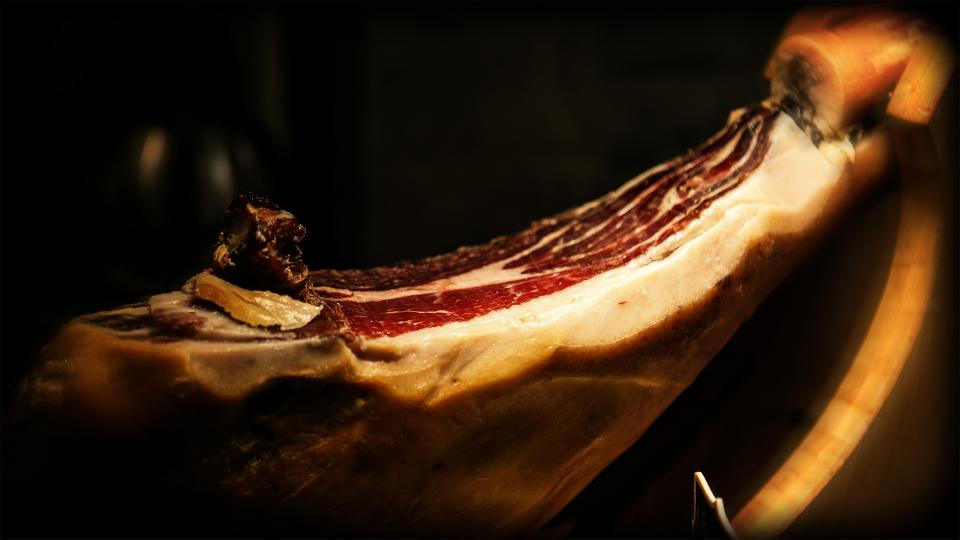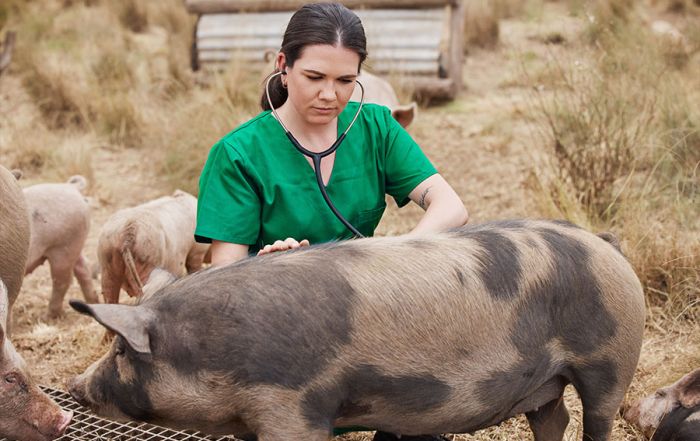Food Safety for Pork – Part 2
Continued from part 1…
Trichinosis parasite is no longer much of a threat in U.S. pork. All pork must be adequately cooked to eliminate disease-causing parasites and bacteria that may be present. Humans may contract trichinosis (caused by the parasite, Trichinella spiralis) or other foodborne illnesses by eating undercooked pork. However, much progress has been made in reducing trichinosis in grain-fed hogs and human cases have greatly declined since 1950. Because of modern feeding practices, trichinosis is a no longer of significant concern. Even if the parasite is present, it will be killed at 137° F. That’s well below the recommended consumer level end cooking temperature for pork, which is 160° F (home consumer cooking temps are always higher than the FDA Food Code for restaurants and food service).
FDA Food Code & Lower Pork Cooking Temperature—For commercial food service, pork can be cooked to safe lower minimum internal temperatures to maintain texture and taste. Review the Food Code quotes for cooking raw animal foods including pork in Chapter 3, Part 4 at http://www.cfsan.fda.gov/~acrobat/fc05-3.pdf
• Whole cuts of raw pork, such as chops, pork ribs, or pork steak must be cooked to 145°F for 15 seconds.
• Whole pork roasts must be cooked to 145°F and held at that temperature for at least 3 minutes.
• With a combination of longer time and lower temperature, pork tenderloin roasts, whole cured ham roasts & other slow cooked pork roasts can be cooked to 130°F for at least 112 minutes (based on pork roast weight, oven air temperature, and humidity). There is a chart in Chapter 3 of the FDA Food Code for these recommendations.
• Ground raw pork, pork sausage, injected meats such as water added hams must be cooked to 155°F for 15 seconds.
• Stuffed pork chops or stuffed roasts and must be cooked to 165°F for 15 seconds.
• Leftover cooked pork must be cooked to 165°F for 15 seconds.
• Raw pork must be separated during storage, preparation, holding, and display. Use separate cutting boards and utensils in contact with all other animal species
• Cold holding for raw pork is 41°F of below. Colder than 41°F extends shelf life.
• Wash hands before and after handling any raw pork.
Irradiation (a form of cold pasteurization with safe radiation) has also been approved for use on pork by the Food and Drug Administration (FDA) and the USDA/FSIS in low-doses to control trichinella. Treated pork would not be sterile and would still need to be handled safely. Trichinella could be alive but would be unable to reproduce. Packages of irradiated pork must be labeled with the irradiation logo as well as the words “Treated with Irradiation” or “Treated by Irradiation” so they would be easily recognizable at the grocery store.
The OINK Quiz for Non-farmers & City Slickers:
1.) How many swine breeds are there in the U.S. today?
A) 8
B) 12
C) 15
2.) What is another name for a female swine?
A) Boars
B) Barrows
C) Gilts
3.) What do you call the offspring of a male and female swine?
A) piglet,
B) pig
C) Both A & B
4.) When a sow gives birth approx. how many babies are usually in the group?
A) 1-4
B) 8-12
C) 20-25
5.) When a pig is 6 month old and is “market weight” how much does it usually weigh?
A) 140 pounds
B) 250 pounds
C) 400 pounds
6.) What’s the heaviest hog ever recorded?
A) 800 pounds
B) 1500 pounds
C) 2500+ pounds
7.) Meats are graded by USDA for quality. How many “grades” of pork are there?
A) 2
B) 5
C) 10
The OINK Quiz Answers
1 — A. There are eight major swine breeds in the United States today: Duroc, Landrace, Chester White, Poland China, Berkshire, Spots, Yorkshire, and Hampshire.
2 — C. Female swine are called gilts. After a gilt has given birth, she is called a sow. Male swine are either boars or barrows. Boars are male swine that are capable of producing offspring. Barrows are male swine that have been neutered and are not capable of reproducing.
3 — C. The offspring of a boar and a sow is a piglet or pig. When a sow gives birth, it is called farrowing.
4 — B. A sow gives birth to a group of 8-12 piglets, called a litter.
5 — B. When a pig is about 6-months old and at market weight (around 250 pounds), it is called a hog. Much of a hog is cured and made into ham, bacon and sausage. Uncured meat is called “fresh pork.”
6 — C. A Poland China hog named “Big Bill” weighing 2,552 pounds and measuring 9 feet long with a belly that dragged the ground was owned by Burford Butler of Jackson, Tennessee, in 1933. That’s some bacon!
7 — A. USDA grades for pork quality reflect only two levels: “Acceptable” grade and “Utility” grade. Pork sold as Acceptable quality pork is the only fresh pork sold in supermarkets and restaurants. It should have a high proportion of lean meat to fat and bone and the lean meat should be grayish pink and firm with fine marbling. Pork graded as Utility is mainly used in processed products and is not available in supermarkets for consumers to purchase. Yield grades may be assigned as U.S. No. 1, 2, 3, 4 or Utility. U.S. yield grade No. 1 is the highest grade a carcass can receive and is based on the yield of the four lean cuts including Ham, Loin, Blade shoulder and arm shoulder. The more muscle and less fat, the more useable, fresh pork can be sold from the carcass. Unacceptable lean meat quality, includes dark red lean meat, soft and oily fat, or bellies too thin for bacon production, are given a U. S. Utility grade.
Bottom Line: So what does the quiz have to do with food safety? Not so much, but good for your food knowledge trivia. Enjoy that safely prepared hot dog, Iowa chop, barbeque pork, ham sandwich, or pork tenderloin.
***
About the Author: Lacie Thrall

This information is provided as a general guideline and is not intended to be, nor does it, constitute legal or regulatory advice. Additional Federal regulations may apply to your particular circumstances. State, regional and local laws, ordinances and regulations may also apply. Quiz source: www.pork.org
Never Did I Ever…
Yes, I know the real game is “never have I ever”, but that phrase didn’t work [...]
Understanding Food Contamination in Foodservice Operations
Within this blog, I’ve provided a lot of details about the finer points of food safety [...]
The Antibiotic Debate in Our Food Chain
The discovery of antibiotics in medical science is regarded as one of the most important medical [...]
Exposing the Risks of Raw Milk
When I began my career in the food safety area several years ago, I never dreamed [...]










